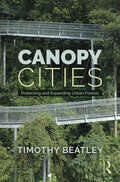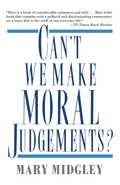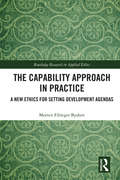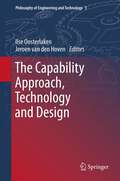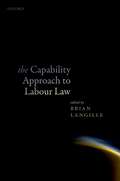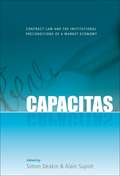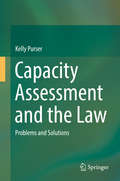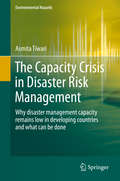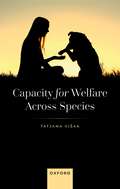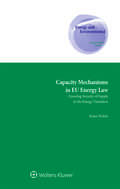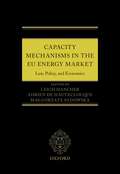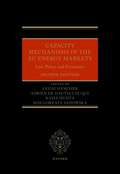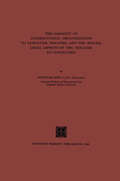- Table View
- List View
Canopy Cities: Protecting and Expanding Urban Forests
by Timothy BeatleyThis book provides a comprehensive overview of the essential role of trees and forests in cities and examines the creative approaches cities around the world are taking to protect trees and expand their urban forests. Moving beyond the view that trees are luxuries and therefore non-essential to the life of a city, the book examines urban tree policies and approaches that foster tree protection, including tree codes and bylaws, and calls for greater community engagement to preserve this important facet of urban life. Through an international range of examples and case studies, featuring cities in the United States, Canada, Singapore, the Netherlands, Australia, France, New Zealand, Mexico, Sierra Leone, and the United Kingdom. The book offers best practice examples where trees have been further integrated into the fabric of urban planning and design, including forested towers, interior rainforests, tiny urban forests, and metropolitan forests. Written by a leading authority in the field, this is a fascinating read for researchers, students, and practitioners in urban planning, landscape architecture, and environmental policy and planning.
Can't We Make Moral Judgements? (Bloomsbury Revelations)
by Mary MidgleyHow many times do we hear the statement 'It's not for me to judge'? It conveys one of the most popular ideas of our time: that to make judgements of others is essentially wrong. In this classic text, the renowned moral philosopher Mary Midgely turns a spotlight on the ever popular stance in society that we should not make moral judgements on others. Guiding the reader through the diverse approaches to this complex subject, she interrogates our strong beliefs about such things as the value of freedom that underlie our scepticism about making moral judgements. She shows how the question of whether or not we can make these judgements must inevitably affect our attitudes not only to the law and its institutions but also to events that occur in our daily lives, and suggests that mistrust of moral judgements may be making life even harder for us than it would be otherwise. The texts and philosophers discussed range from Nietzsche and Sartre to P.D. James and the Bhagavad Gita. The Bloomsbury Revelations edition includes a new preface from the author.
Can't We Make Moral Judgements? (Bloomsbury Revelations)
by Mary MidgleyHow many times do we hear the statement 'It's not for me to judge'? It conveys one of the most popular ideas of our time: that to make judgements of others is essentially wrong. In this classic text, the renowned moral philosopher Mary Midgely turns a spotlight on the ever popular stance in society that we should not make moral judgements on others. Guiding the reader through the diverse approaches to this complex subject, she interrogates our strong beliefs about such things as the value of freedom that underlie our scepticism about making moral judgements. She shows how the question of whether or not we can make these judgements must inevitably affect our attitudes not only to the law and its institutions but also to events that occur in our daily lives, and suggests that mistrust of moral judgements may be making life even harder for us than it would be otherwise. The texts and philosophers discussed range from Nietzsche and Sartre to P.D. James and the Bhagavad Gita. The Bloomsbury Revelations edition includes a new preface from the author.
Can't We Make Moral Judgements?
by NA NAIn this book, Mary Midgely turns a spotlight on the fashionable view that we no longer need or use moral judgements. She shows how the question of whether or not we can make moral judgements must inevitably affect our attitudes to the law and its institutions, but also to events that occur in our daily lives.
The Capability Approach in Practice: A New Ethics in Setting Development Agendas (Routledge Research in Applied Ethics)
by Morten Fibieger ByskovThis book develops a philosophical framework for selecting goals for development purposes. This inclusive and democratic framework integrates a variety of resources including philosophical theory, empirical analysis, stakeholder deliberations, local knowledge, and advice from development experts. The author contends that we must provide good reasons and arguments in order to justify a particular development agenda. That is, we need to ask why we choose certain kinds of development goals over others, why we include certain agents in the selection process and not others, and why we select goals through one method rather than another. In response to these questions, the author argues that development should aim at expanding people’s capabilities and functionings. Capabilities and functionings—capabilities that have been realized—tell us what people are actually able to do and be with their resources, goods, and formal freedoms. He advances the view that local stakeholders should have more authority in deciding what a development agenda looks like. This claim to local authority in development can be interpreted both as a claim to political authority and expert authority. Finally, the author argues that ad hoc, foundational, procedural, and mixed (multi-stage) methods need to be synthesized in order to select the best capabilities and functionings for development. The Capability Approach in Practice provides a philosophical and systematic approach to setting development agendas. It is an important contribution to the literature on the capability approach and development ethics, which will appeal to a broad range of scholars within philosophy and development studies.
The Capability Approach in Practice: A New Ethics in Setting Development Agendas (Routledge Research in Applied Ethics)
by Morten Fibieger ByskovThis book develops a philosophical framework for selecting goals for development purposes. This inclusive and democratic framework integrates a variety of resources including philosophical theory, empirical analysis, stakeholder deliberations, local knowledge, and advice from development experts. The author contends that we must provide good reasons and arguments in order to justify a particular development agenda. That is, we need to ask why we choose certain kinds of development goals over others, why we include certain agents in the selection process and not others, and why we select goals through one method rather than another. In response to these questions, the author argues that development should aim at expanding people’s capabilities and functionings. Capabilities and functionings—capabilities that have been realized—tell us what people are actually able to do and be with their resources, goods, and formal freedoms. He advances the view that local stakeholders should have more authority in deciding what a development agenda looks like. This claim to local authority in development can be interpreted both as a claim to political authority and expert authority. Finally, the author argues that ad hoc, foundational, procedural, and mixed (multi-stage) methods need to be synthesized in order to select the best capabilities and functionings for development. The Capability Approach in Practice provides a philosophical and systematic approach to setting development agendas. It is an important contribution to the literature on the capability approach and development ethics, which will appeal to a broad range of scholars within philosophy and development studies.
The Capability Approach, Technology and Design (Philosophy of Engineering and Technology #5)
by Ilse Oosterlaken and Jeroen HovenThe capability approach of Martha Nussbaum and Amartya Sen places human capabilities at the centre stage of discussions about justice, equality, development and the quality of life. It rejects too much emphasis on mere preference satisfaction or resource provision and highlights the importance of human agency and freedom. This approach has already significantly influenced different fields of application, such as economics and development studies. Only recently have scholars started to explore its relevance for and application to the area of technology and design, which can be crucial factors in the expansion of human capabilities. How does technology influence human capabilities? What difference could a capability approach make to policies and practices of applying ICT in development processes in the South? How can we criticize and improve the design of technology from the perspective of the capability approach? The authors of this volume explore the implications of the capability approach for technology & design and together create the first volume on this emerging topic.
The Capability Approach to Labour Law
by Brian LangilleForty years ago Amartya Sen introduced to the world a novel approach to the idea of equality: the notion of 'basic capability' as 'a morally relevant dimension' and the claim that we should focus upon equality of basic capabilities ('a person being able to do certain basic things'). These ideas, as developed by Sen and Martha C. Nussbaum, have launched an academic armada now proceeding under the flag of the 'capability approach' (CA). While that flag has ventured far and wide and engaged many areas of inquiry, this volume of essays is the first to explore how CA might shed light upon labour law. The capabilities approach can illuminate our understanding of labour law across three dimensions. Part I looks at the nature of the basic relationship between CA and labour law-do they share common ground or disagree about what is important? Can the CA provide a normative 'foundation' for labour law? Part II goes further by examining the relationship of the CA and other well-established perspectives on labour law, including economics, history, critical theory, restorative justice, and human rights. Part III examines the possible relevance of the CA to a range of specific labour law issues, such as freedom of association, age discrimination in the workplace, trade, employment policy, and sweatshop goods.
The Capability Approach to Labour Law
Forty years ago Amartya Sen introduced to the world a novel approach to the idea of equality: the notion of 'basic capability' as 'a morally relevant dimension' and the claim that we should focus upon equality of basic capabilities ('a person being able to do certain basic things'). These ideas, as developed by Sen and Martha C. Nussbaum, have launched an academic armada now proceeding under the flag of the 'capability approach' (CA). While that flag has ventured far and wide and engaged many areas of inquiry, this volume of essays is the first to explore how CA might shed light upon labour law. The capabilities approach can illuminate our understanding of labour law across three dimensions. Part I looks at the nature of the basic relationship between CA and labour law-do they share common ground or disagree about what is important? Can the CA provide a normative 'foundation' for labour law? Part II goes further by examining the relationship of the CA and other well-established perspectives on labour law, including economics, history, critical theory, restorative justice, and human rights. Part III examines the possible relevance of the CA to a range of specific labour law issues, such as freedom of association, age discrimination in the workplace, trade, employment policy, and sweatshop goods.
Capable Women, Incapable States: Negotiating Violence and Rights in India (Modern South Asia)
by Poulami RoychowdhuryIn recent decades, the issue of gender-based violence has become heavily politicized in India. Yet, Indian law enforcement personnel continue to be biased against women and overburdened. In Capable Women, Incapable States, Poulami Roychowdhury asks how women claim rights within these conditions. Through long term ethnography, she provides an in-depth lens on rights negotiations in the world's largest democracy, detailing their social and political effects. Roychowdhury finds that women interact with the law not by following legal procedure or abiding by the rules, but by deploying collective threats and doing the work of the state themselves. And they behave this way because law enforcement personnel do not protect women from harm but do allow women to take the law into their own hands.These negotiations do not enhance legal enforcement. Instead, they create a space where capable women can extract concessions outside the law, all while shouldering a new burden of labor and risk. A unique theory of gender inequality and governance, Capable Women, Incapable States forces us to rethink the effects of rights activism across large parts of the world where political mobilization confronts negligent criminal justice systems.
CAPABLE WOMEN, INCAPABLE STATES MSA C: Negotiating Violence and Rights in India (Modern South Asia)
by Poulami RoychowdhuryIn recent decades, the issue of gender-based violence has become heavily politicized in India. Yet, Indian law enforcement personnel continue to be biased against women and overburdened. In Capable Women, Incapable States, Poulami Roychowdhury asks how women claim rights within these conditions. Through long term ethnography, she provides an in-depth lens on rights negotiations in the world's largest democracy, detailing their social and political effects. Roychowdhury finds that women interact with the law not by following legal procedure or abiding by the rules, but by deploying collective threats and doing the work of the state themselves. And they behave this way because law enforcement personnel do not protect women from harm but do allow women to take the law into their own hands.These negotiations do not enhance legal enforcement. Instead, they create a space where capable women can extract concessions outside the law, all while shouldering a new burden of labor and risk. A unique theory of gender inequality and governance, Capable Women, Incapable States forces us to rethink the effects of rights activism across large parts of the world where political mobilization confronts negligent criminal justice systems.
Capacitas: Contract Law and the Institutional Preconditions of a Market Economy
by Simon Deakin Alain SupiotOne of the principal tasks for legal research at the beginning of the 21st century is to reconstruct the understanding of the relationship between the legal system and the market order. After almost three decades of deregulation driven by a belief in the self-equilibrating properties of the market, the financial crisis of 2008 has reminded everyone of the fundamental truth that markets have legal and institutional foundations, without which they cannot effectively function. The chapters in the present volume are the result of work by a group of legal scholars which began in the mid-2000s, at a time when the shortcomings of deregulatory policies were becoming clear in a number of contexts. The chapters address the question of how the language of contract law describes or conceptualises the market order and the relationship of the law to it. The perspectives taken are, in turn, historical, comparative, and context-specific. The focus of the book is on a foundational idea, the concept of capacitas, which signifies a status conferred upon citizens for the purpose of enabling them to participate in the economic life of the polity. In modern legal systems, 'capacity' is the principal juridical mechanism by which individuals and entities are empowered to enter into legally binding agreements and, more generally, to arrange their affairs using the instruments of private law. Legal capacity is thereby the gateway to involvement in the operations of a market economy.
Capacity Assessment and the Law: Problems and Solutions
by Kelly PurserThis book discusses theoretical issues, standards, and professional considerations arising when legal and health practitioners undertake legal capacity assessments in the context of wills, enduring powers of attorney and advance health directives. The potential loss of cognition can erode autonomy as individuals lose the ability to make their own legally recognised decisions. This is an inescapable problem with significant legal, social, health and policy repercussions. This work synthesises and critically analyses the existing literature, including some of the best assessment models and guiding principles internationally, to generate a new methodology and understanding of what capacity assessment best practice means. This includes the impact of assessments on individual autonomy - the ideal method building upon respect for both autonomy as well as fundamental human rights. The triggers to assess capacity, who to involve in the assessment process, as well as how to conduct that assessment process are discussed. The crucial relationship between the legal and health professionals involved in assessments, including growing concerns around practitioner liability, is also explored. This analysis is undertaken through the innovative use of a therapeutic jurisprudence lens, the effect of which is to contribute new knowledge to this complex field.
Capacity Building in National Environmental Policy: A Comparative Study of 17 Countries
by H. JörgensThis book is the second collection of systematic case studies describing national environmental policies in 17 countries in terms of capacity building (see Appen dix). The OECD defines environmental capacity building as "a society's ability to identify and solve environmental problems. " While various institutions, including UNEP, FAO, World Bank and OECD, have hitherto used the terms environmental capacity and capacity building almost exclusively with reference to developing countries, we have extended the concepts to industrialized countries, as well. The first collection, edited by Martin Janicke, Helge Joergens (both Free University Berlin) and Helmut Weidner (Social Science Research Center Berlin), was pub lished in 1997 under the title "National Environmental Policies - A Comparative Study of Capacity-Building" (Berlin, etc. : Springer Verlag). It included 13 studies of countries. As in the first volume, chapter I presents the conceptual framework underlying the national case studies. It is a slightly shorter version of the corresponding chap ter in volume I. The design of all case studies in the two volumes is largely con gruent with this conceptual framework. Although the various sections of the stud ies do not always have identical titles and subtitles, the central elements of the capacity-building approach have been applied in all cases.
The Capacity Crisis in Disaster Risk Management: Why disaster management capacity remains low in developing countries and what can be done (Environmental Hazards)
by Asmita TiwariHow can a place be built and managed so that it is safe for people to live? Ironically, many governments and citizens keep on asking the same question after every new disaster. Why, even with high levels of investment in increasing government’s capacity to manage disasters, do the impacts of disasters continue to increase? What can the governments do differently? What is the role of local communities? Where should aid agencies invest? This book looks into these critical questions and highlights how current capacity development efforts might be resulting in the opposite—capacity crisis or capability trap. The book provides a new approach for the understanding and the developing of effective local capacity to reduce and manage future disaster impacts.
The Capacity for Ethical Conduct: On psychic existence and the way we relate to others
by David P. LevineWhat is the root cause of ethical failure? Why is preoccupation with ethics more a part of the problem than a part of the solution? What makes ethical conduct a natural expression of who we are? What enables us to be ourselves in our relations with others? Ethical failure has become a significant concern in public life, in organizations and in educational institutions. The Capacity for Ethical Conduct explores how qualities of character and personality either make ethical conduct possible for the individual or foster ethical failure. David Levine discusses how ethical conduct is a special way of relating to others, one that secures respect for their integrity by assuring that what they do can express who they are. He argues that this special way of relating to others results not from knowledge of, or a stated commitment to, rules, norms and values, but from the way we experience ourselves, especially from our ability to make a positive emotional investment in being and having a self. Traditionally, emphasis on the importance of values and ethics in shaping conduct tends to be connected to the need to find fault in self and others, fostering an atmosphere where the self is put at risk in its relations to others. This means that an excessive emphasis on ethics, rather than assuring ethical conduct, tends instead to create interpersonal settings marked by emotional assault. Because of this, talk about ethics often expresses ambivalence about ethical conduct, which makes the familiar combination of preoccupation with ethics and ethical failure unsurprising. The Capacity for Ethical Conduct explores the ways in which the interpersonal world of work either fosters a feeling of safety or encourages various forms of emotional assault. Presenting case studes and applying psychoanalytic object relation theory and self psychology, this book explores the factors underlying ethical failure and the capacity for ethical conduct. It will be of interest to scholars and practioners in the fields of psychoanalysis, psychology, philosophy, sociology, organizational dynamics, management and public administration.
The Capacity for Ethical Conduct: On psychic existence and the way we relate to others
by David P. LevineWhat is the root cause of ethical failure? Why is preoccupation with ethics more a part of the problem than a part of the solution? What makes ethical conduct a natural expression of who we are? What enables us to be ourselves in our relations with others? Ethical failure has become a significant concern in public life, in organizations and in educational institutions. The Capacity for Ethical Conduct explores how qualities of character and personality either make ethical conduct possible for the individual or foster ethical failure. David Levine discusses how ethical conduct is a special way of relating to others, one that secures respect for their integrity by assuring that what they do can express who they are. He argues that this special way of relating to others results not from knowledge of, or a stated commitment to, rules, norms and values, but from the way we experience ourselves, especially from our ability to make a positive emotional investment in being and having a self. Traditionally, emphasis on the importance of values and ethics in shaping conduct tends to be connected to the need to find fault in self and others, fostering an atmosphere where the self is put at risk in its relations to others. This means that an excessive emphasis on ethics, rather than assuring ethical conduct, tends instead to create interpersonal settings marked by emotional assault. Because of this, talk about ethics often expresses ambivalence about ethical conduct, which makes the familiar combination of preoccupation with ethics and ethical failure unsurprising. The Capacity for Ethical Conduct explores the ways in which the interpersonal world of work either fosters a feeling of safety or encourages various forms of emotional assault. Presenting case studes and applying psychoanalytic object relation theory and self psychology, this book explores the factors underlying ethical failure and the capacity for ethical conduct. It will be of interest to scholars and practioners in the fields of psychoanalysis, psychology, philosophy, sociology, organizational dynamics, management and public administration.
Capacity for Welfare across Species
by Tatjana VišakIs my dog, with his joyful and carefree life, better off than I am? Do hens in battery cages have worse lives than cows at pasture? Will my money improve welfare more if I spend it on helping people or if I benefit chickens? How can we assess the harm of climate change for both humans and non-humans? If we want to systematically compare welfare across species, we first need to explore whether welfare subjects of different species have the same or rather a different capacity for welfare. According to what seems to be the dominant philosophical view, welfare subjects with higher cognitive capacities have a greater capacity for welfare and are generally much better off than those with lower cognitive capacities. Višak carefully explores and rejects this view. She argues instead that welfare subjects of different species have the same capacity for welfare despite different cognitive capacities. This book prepares the philosophical ground for comparisons of welfare across species. It will inform and inspire ethicists and animal welfare scientists alike, as well as a broader readership interested in wellbeing, animals, and ethics. Besides different views about capacity for welfare across species, the book discusses animal capacities, moral status, harm of death, whether bringing additional well-off individuals into existence is a good thing, and practical implications of these topics for counting and comparing the welfare of animals of different species.
Capacity for Welfare across Species
by Tatjana VišakIs my dog, with his joyful and carefree life, better off than I am? Do hens in battery cages have worse lives than cows at pasture? Will my money improve welfare more if I spend it on helping people or if I benefit chickens? How can we assess the harm of climate change for both humans and non-humans? If we want to systematically compare welfare across species, we first need to explore whether welfare subjects of different species have the same or rather a different capacity for welfare. According to what seems to be the dominant philosophical view, welfare subjects with higher cognitive capacities have a greater capacity for welfare and are generally much better off than those with lower cognitive capacities. Višak carefully explores and rejects this view. She argues instead that welfare subjects of different species have the same capacity for welfare despite different cognitive capacities. This book prepares the philosophical ground for comparisons of welfare across species. It will inform and inspire ethicists and animal welfare scientists alike, as well as a broader readership interested in wellbeing, animals, and ethics. Besides different views about capacity for welfare across species, the book discusses animal capacities, moral status, harm of death, whether bringing additional well-off individuals into existence is a good thing, and practical implications of these topics for counting and comparing the welfare of animals of different species.
Capacity Mechanisms in EU Energy Law: Ensuring Security of Supply in the Energy Transition
by Kaisa HuhtaMany states – including European Union (EU) Member States – subsidise energy producers in order to guarantee the uninterrupted availability of affordable electricity. This book presents the first in-depth examination of how these so-called capacity mechanisms are addressed in EU law and how they affect the functioning of the EU energy markets. Focusing on the existing legal framework as well as the new provisions of the Clean Energy for All Europeans package for capacity mechanisms, the author addresses and analyses such aspects as the following: the structure and functioning of the EU electricity markets; EU’s competence to address security of supply and Member States’ margin of discretion; sector-specific rules for security of supply; legal conditions for subsidising generation adequacy; capacity remuneration under the EU State aid regime; free movement rules that address generation adequacy measures; balancing different interests of EU energy law in the context of generation adequacy; and the requirement of proportionality in State intervention to ensure generation adequacy. The analysis draws on relevant sources of EU law (treaties, regulations and directives) as well as the case law of the European Court of Justice and the General Court, together with soft law instruments such as Commission guidelines. Scholarly sources include not only legal literature but also work on energy policy, energy engineering and energy economics. As a detailed analysis of how capacity mechanisms address issues arising in the context of the enegy transition – and how the system of EU law applicable to capacity mechanisms should be interpreted to further the objectives of EU energy law – the book will help policymakers and legislators in Member States to understand the changing legal setting for capacity mechanisms. Lawyers, academics and other professionals who deal with EU electricity markets in the EU and beyond are sure to welcome its detailed description and analysis.
Capacity Mechanisms in the EU Energy Market: Law, Policy, and Economics
by Leigh Hancher Adrien De Hauteclocque Malgorzata SadowskaEnsuring an adequate, long-term energy supply is a paramount concern in Europe. EU member states now intervene by encouraging investment in generation capacity, offering an additional revenue stream for conventional power plants in addition to the existing, heavily subsidised investments in renewable energy sources. These capacity remuneration mechanisms (or simply capacity mechanisms) have become a hot topic in the wider European regulatory debate. European electricity markets are increasingly interconnected, so the introduction of a capacity mechanism in one country not only distorts its national market but may have unforeseeable consequences for neighbouring electricity markets. If these mechanisms are adopted by several member states with no supra-national coordination and no consideration for their cross-border impact, they may cause serious market distortions and put the future of the European internal electricity market at risk. This book provides readers with an in-depth analysis of capacity mechanisms, written by an expert team of policy-makers, economists, and legal professionals. It will be a first point of reference for regulators and policy-makers responsible for designing optimal capacity mechanisms in Europe, and will be an invaluable resource for academics and practitioners in the fields of energy, regulation, and competition.
Capacity Mechanisms in the EU Energy Markets: Law, Policy, and Economics
by Leigh Hancher, Adrien De Hauteclocque, Kaisa Huhta and Małgorzata SadowskaCapacity remuneration mechanisms (or simply capacity mechanisms) have become a fact of life in member states' energy markets and are one of the hottest topics in the wider European regulatory debate. Concerned about the security of electricity supply, national governments are implementing subsidy schemes to encourage investment in conventional power generation capacity, alongside already heavily subsidized renewable energy sources. With the increasingly connected European electricity markets, the introduction of a capacity mechanism in one country not only tends to distort its national market but may also have unforeseeable consequences for neighbouring electricity markets. As these mechanisms are adopted by member states with limited supra-national coordination as well as consideration for the cross-border impact, they tend to cause serious market distortions and put the future of the European internal electricity market at risk. This second edition will take stock of how capacity mechanisms have actually worked so far and consider the consequences they have for the European internal electricity market. It will include a detailed overview of national capacity mechanisms, their implications for the EU internal market, and will outline the nature of market failures which are likely to occur in the European electricity markets. This edition is intended to serve as a point of reference for regulators and policy-makers on how to design optimal capacity mechanisms in Europe. It will be an invaluable resource for anyone interested in energy market design, regulation, and competition issues.
Capacity Mechanisms in the EU Energy Markets: Law, Policy, and Economics
Capacity remuneration mechanisms (or simply capacity mechanisms) have become a fact of life in member states' energy markets and are one of the hottest topics in the wider European regulatory debate. Concerned about the security of electricity supply, national governments are implementing subsidy schemes to encourage investment in conventional power generation capacity, alongside already heavily subsidized renewable energy sources. With the increasingly connected European electricity markets, the introduction of a capacity mechanism in one country not only tends to distort its national market but may also have unforeseeable consequences for neighbouring electricity markets. As these mechanisms are adopted by member states with limited supra-national coordination as well as consideration for the cross-border impact, they tend to cause serious market distortions and put the future of the European internal electricity market at risk. This second edition will take stock of how capacity mechanisms have actually worked so far and consider the consequences they have for the European internal electricity market. It will include a detailed overview of national capacity mechanisms, their implications for the EU internal market, and will outline the nature of market failures which are likely to occur in the European electricity markets. This edition is intended to serve as a point of reference for regulators and policy-makers on how to design optimal capacity mechanisms in Europe. It will be an invaluable resource for anyone interested in energy market design, regulation, and competition issues.
The Capacity of International Organizations to Conclude Treaties, and the Special Legal Aspects of the Treaties so Concluded
by Hungdah ChiuMter an international organization is established, if it is necessary for it to acquire certain rights or assume duties or new functions not provided in its constitution, there are four techniques to achieve that 1 end. The first is to amend the constitution of the organization. If the organization has only a limited number of members, then this technique is not too cumbersome. But, the procedure for amending a constitution is usually complicated and requires a substantial period of time. Thus this technique has at least the disadvantage of delay. 2 The second technique is to conclude a treaty among the member States of the organization. The organization is not a party to that treaty, but it can acquire some rights, assume some duties, or new functions under the treaty. 3 The disadvantage of this technique is similar to the first one, i. e. , the conclusion of a multilateral treaty may mean delay since the procedure involved is so complicated and cumber some. 1 E. g. , the Constitution of the ILO, Cmd. No. 393 (T. S. No. 4 of 1919), [1919] 13 Foreign ReI. U. S. : Paris Conf. 695 (1947), was amended on October 9, 1946,62 Stat. 3485, T. I. A. S. No. 1868, 15 U. N. T. S.
Capacity, Participation and Values in Comparative Legal Perspective
by Camillia Kong, John Coggon, Penny Cooper, Michael Dunn andWith contributions from an international team of experts, this collection provides a much-needed international, comparative approach to mental capacity law. The book focuses particularly on exploring substantive commonalities and divergences in normative orientation and practical application embedded in different legal frameworks. It draws together contributions from eleven different jurisdictions across Europe, Asia and the UK and explores what productive or unproductive values and practices currently exist. By providing a detailed comparison of how legal and ethical commitments to persons with disabilities are framed in capacity law across different national systems, the book highlights the values and practices that could lead to changes that better respect persons with disabilities in mental capacity regimes.
